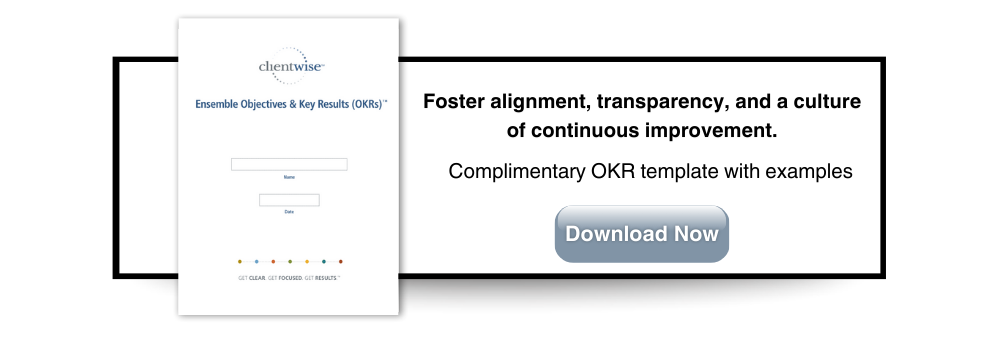6 Tips For Integrating OKRs With EOS To Amplify Performance
High-performing advisory teams leverage valuable frameworks such as Objectives and Key Results (OKRs) and the Entrepreneurial Operating System (EOS) to set strategic goals, drive execution, and achieve business results. While each framework offers unique benefits, integrating OKRs with EOS can supercharge organizational performance and propel financial advisors and their teams to achieve their goals.
Before delving into integration strategies, however, let's briefly recap what OKRs and EOS are, as well as what they involve and accomplish:
- Objectives and Key Results (OKRs): popularized by John Doerr, OKRs are a simple framework designed to drive 10X growth. His book Measure What Matters describes the goal-setting framework that helps organizations define ambitious objectives and measurable key results to track progress. OKRs foster alignment, transparency, and a culture of continuous improvement.
- Entrepreneurial Operating System (EOS): developed by Gino Wickman and outlined in his book Traction, EOS is a holistic framework designed to help organizations clarify their vision, streamline operations, and achieve traction. EOS comprises six key components: vision, people, data, issues, process, and traction.
Each book provides easy-to-use insights on how to best drive performance utilizing their frameworks. Doerr's book also happens to be one of my favorite audiobooks, with each chapter (aside from the core content chapters of 4, 7 and 12) read by CEOs of companies that have successfully installed OKRs.
While both are powerful performance enhancements tools in their own right, when you take the time to integrate OKRs with EOS there are four critical benefits your advisory business derives:
- Alignment: Integrating OKRs with EOS ensures closer alignment between your short-term objectives and long-term vision—fostering greater organizational clarity and focus.
- Execution: Leveraging EOS tools and processes for OKR execution helps streamline operations, enhances accountability, and drives results.
- Data-Driven Decision-Making: By incorporating data into OKR tracking through EOS, your business can make more informed decisions and course corrections – significantly improving the likelihood of sustained success.
- Cross-Functional Collaboration: Integration of these two frameworks promotes cross-functional alignment and collaboration, breaking down silos, and fostering a unified approach toward goal achievement.
So, what’s the optimal way to go about integrating OKRs and EOS?
- Align OKRs with EOS Vision: Start by aligning your OKRs with the vision and long-term goals established through EOS. Ensure your OKRs align with your firm's overarching purpose and direction, as this alignment will help ensure that every objective contributes directly to realizing your organizational vision.
- Incorporate OKRs into your Quarterly ROCS: In the EOS framework, quarterly ROCS are priority initiatives that drive progress toward the vision. Integrate OKRs seamlessly into your quarterly ROCS by setting OKRs that align with them. Then, define key results as milestones for achieving your ROCS to help reinforce alignment between the two frameworks.
- Leverage EOS Tools for OKR Execution: EOS provides tools and processes to facilitate execution and accountability. Use these tools (e.g., the Level 10 Meeting™ and Accountability Chart) to track OKR progress, discuss obstacles, and ensure alignment within the team. Integrate OKR updates and discussions into your EOS meetings to maintain focus and momentum.
- Utilize Data for OKR Tracking: Data-driven decision-making is a cornerstone of OKRs and EOS. Make sure you leverage data to track OKR progress, identify trends, and make informed adjustments. Incorporate relevant metrics and key performance indicators (KPIs) into your EOS Scorecard™ to monitor OKR performance and drive accountability.
- Promote Cross-Functional Alignment: OKRs and EOS encourage cross-functional collaboration and alignment. Seek to foster communication and collaboration across teams to ensure that OKRs are understood and supported at all levels of the organization. Encourage departments to align their OKRs with the broader organizational objectives defined through EOS to foster a cohesive and united approach toward goal achievement.
- Iterate and Improve: Both OKRs and EOS emphasize a culture of continuous improvement. Regularly review OKR performance and EOS implementation, solicit feedback from team members and stakeholders. And periodically identify areas for refinement and enhancement, improve your processes and strategies in an effort to drive better outcomes.
Integrating OKRs with EOS offers your enterprise a powerful framework for setting and achieving strategic goals. By aligning OKRs with EOS vision, incorporating OKRs into quarterly ROCS, leveraging EOS tools for execution, utilizing data for tracking, promoting cross-functional alignment, and iterating for improvement, you’ll have an opportunity to unlock synergies and drive exceptional performance.
By simply embracing integration, you’ll have the means to elevate your practice to new heights of success and sustainability.
For instant blog notifications subscribe below!
Topics: Business Development Operations



